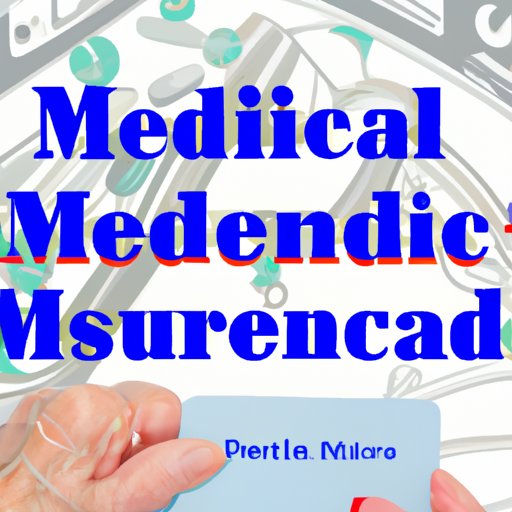Overview of Medicare and Medicaid: What They Are and How They Work
Medicare and Medicaid are two of the most important health care programs in the United States. While they share some similarities, there are also a few key differences that it’s important to understand. In this article, we’ll explore what Medicare and Medicaid are, how they work, and the benefits they offer.

Definition of Medicare and Medicaid
Medicare and Medicaid are both government-funded health insurance programs. Medicare is a federal program that provides health care coverage for people age 65 and over, as well as people with certain disabilities. According to a study by the Kaiser Family Foundation, “In 2018, 58.9 million people, or 18.3% of the U.S. population, were enrolled in Medicare.”
Medicaid is a joint state and federal program that provides health care coverage for low-income individuals and families. It is run by the individual states, who set their own eligibility criteria. The Kaiser Family Foundation estimates that, “in 2018, 74.5 million people, or 23.1% of the U.S. population, were enrolled in Medicaid and CHIP (the Children’s Health Insurance Program).”
How Medicare and Medicaid Work
Medicare and Medicaid both provide access to doctors, hospitals, and other health care providers. However, the way they work is slightly different. Medicare is divided into four parts, Part A, B, C, and D. Parts A and B cover hospital visits, doctor visits, and preventive care. Part C is Medicare Advantage, which is a private health plan offered by private companies. Part D covers prescription drugs.
Medicaid works differently, as each state sets its own rules for eligibility and services covered. Generally, Medicaid covers hospital visits, doctor visits, preventive care, and prescription drugs. Some states also offer additional services, such as vision and dental care.

Exploring the Differences Between Medicare and Medicaid
Although Medicare and Medicaid have some similarities, there are also a few key differences between them.
Coverage Differences
The biggest difference between Medicare and Medicaid is the type of coverage they provide. Medicare provides more comprehensive coverage than Medicaid, including hospital stays, doctor visits, preventive care, and prescription drug coverage. Some states also offer additional services through Medicaid, such as vision and dental care.
Eligibility Requirements
Another key difference between Medicare and Medicaid is the eligibility requirements. Medicare is available to people age 65 and older, as well as people with certain disabilities. Medicaid is available to low-income individuals and families. Each state sets its own eligibility criteria for Medicaid.
Benefits of Medicare and Medicaid for Seniors and Low-Income Individuals
Medicare and Medicaid provide many benefits to seniors and low-income individuals.
Financial Benefits
One of the biggest benefits of Medicare and Medicaid is the financial assistance they provide. Medicare helps seniors pay for health care costs, while Medicaid helps low-income individuals and families pay for medical expenses. This can be especially beneficial for those who cannot afford health insurance on their own.
Health Care Benefits
Medicare and Medicaid also provide access to quality health care. Both programs provide access to doctors, hospitals, and other health care providers. Medicare also covers preventive care services, such as screenings and vaccinations. These services can help keep seniors and low-income individuals healthy.
Exploring the Eligibility Requirements for Medicare and Medicaid
In order to qualify for Medicare or Medicaid, you must meet certain eligibility requirements.
Age Requirements
To be eligible for Medicare, you must be age 65 or older, or you must have certain disabilities. To be eligible for Medicaid, you must meet the income and asset limits set by your state.
Income Limits
Income is one of the main factors used to determine eligibility for both Medicare and Medicaid. For Medicare, you must have an annual income below a certain limit. For Medicaid, your income must be at or below your state’s poverty level.

Understanding the Cost of Medicare and Medicaid Coverage
The cost of Medicare and Medicaid coverage varies depending on your situation.
Premiums
Medicare requires you to pay monthly premiums for Parts B and D, as well as for certain Medicare Advantage plans. Medicaid does not require premiums, but some states do charge premiums for certain services.
Copays and Deductibles
Medicare and Medicaid both require you to pay copays and deductibles for certain services. Copays are a fixed amount you must pay for each visit or service, while deductibles are a set amount you must pay before your insurance will cover the remaining costs.
Conclusion
Medicare and Medicaid are two important health care programs in the United States. While they have some similarities, there are also some key differences between them. It’s important to understand these differences and the eligibility requirements in order to make sure you get the coverage you need. Medicare and Medicaid can provide important financial and health care benefits to seniors and low-income individuals.
(Note: Is this article not meeting your expectations? Do you have knowledge or insights to share? Unlock new opportunities and expand your reach by joining our authors team. Click Registration to join us and share your expertise with our readers.)
